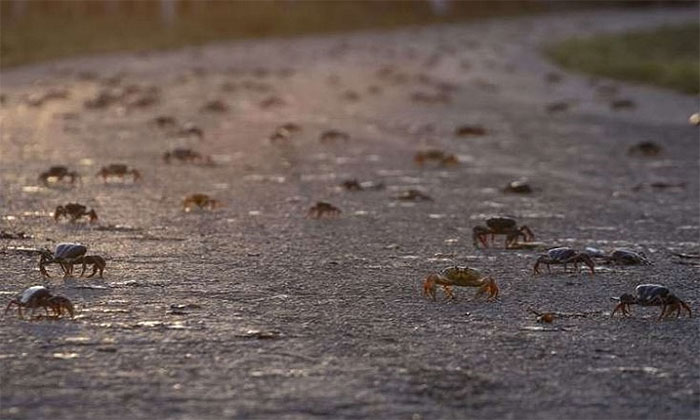Millions of red crabs migrate to the Gulf of Cuba
Every year, millions of crabs emerge from the jungle in early spring and head towards Pigs Bay, crossing dangerous streets and highways to breed.
The migration of red crabs of two species, Gecarcinus ruricola and lateralis, has caused concern to drivers in the town of Giron who must find a way around to avoid killing them. The crabs become a nuisance to local residents, but the sight of them crossing the road is a wonder for first-time visitors and passers-by.
"The crabs got here before us," said Amaury Urra, a 50-year-old climbing guide who has lived all her life in the Caribbean's largest swamp Ciénega de Zapata. "We're used to this."
The town of Giron is located 180 km southeast of Havana. This year, the crabs started migrating early. In late March, local authorities warned drivers to avoid traveling in the morning and evening, the preferred travel times for the crabs. Environmental activists have also demanded the closure of main roads, especially during migration.
The journey of the red crabs can last until July. The crabs flock to the streets most between April and May. Local residents need to be careful during this time because red crabs feel threatened. , they can puncture the tire with the fork.

This year, the crabs started migrating early.
Official figures estimate that around 3.5 million crabs die each migration season, many of which are run over by passing vehicles. Red crabs also live and migrate in the Bahamas, Nicaragua, Jamaica and Dominica. But in Giron and another coastal area near the neighboring province of Cienfuegos, their roads are heavily trafficked.
The migration of the crabs occurred after a two-year epidemic, resulting in unprecedented numbers of crabs. "We observed an unusually high density migration," Reinaldo Santana Aguilar, a scientist at Cuba's environment ministry, told Reuters. "Most likely the crab population has recovered and that's why they're migrating like that."
More than 4 million years ago, Gecarcoidea, the ancestor of these crabs, lived in the sea. However, they evolved slowly to survive in the shaded forest floor. But like sea crabs, red land crabs still breathe with gills. To keep their gills moist, they burrow. During the spring rains, male and female crabs find a mate and mate.
Cuba is not the only island invaded by crabs. A similar species of land crab swarms across Christmas Island in the Indian Ocean every autumn. An estimated 100 million red crabs there crawl to the shore to breed. Male crabs crawl out first and take several weeks to reach the surface. They fight for the best territory. The female crab followed, mating with the male and carrying the egg sac a few weeks later.
In Cuba, the eggs hatch when exposed to seawater and the young crabs begin their journey back to the forest after a while. On both islands, authorities are working to protect the crabs by closing some roads and sidewalks for the crabs to crawl through.
- Amazingly, the crab island spreads all over the city
- Crab dyed red island in Australia
- Three-colored crabs invaded the Pig Bay in Cuba
- Interesting little facts about Cuba
- Top of unprecedented species of crabs
- The stranded crab dyes red the California coast
- Giant sea crabs with fishermen nets
- How to eat crabs?
- Catching super rare purple crabs caused a stir
- Video: Hold 1,000 crabs in the palm of your hand
- Giant crabs weigh up to 4kg
- How to choose crabs, delicious and meaty crabs
 Animal 'suffering' after hibernation
Animal 'suffering' after hibernation Why do goats climb well?
Why do goats climb well? Scientists were surprised to see chimpanzees eating turtles
Scientists were surprised to see chimpanzees eating turtles Giant catfish died deadly due to drought in Thailand
Giant catfish died deadly due to drought in Thailand